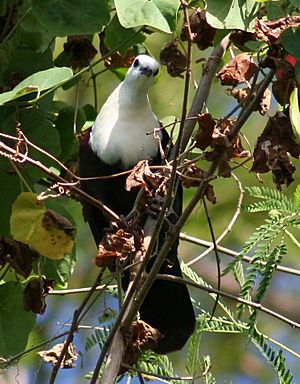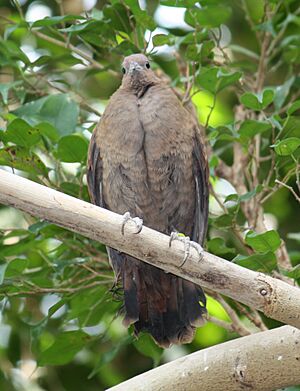White-throated ground dove facts for kids
Quick facts for kids White-throated ground dove |
|
|---|---|
 |
|
| male | |
 |
|
| female | |
| Conservation status | |
| Scientific classification | |
| Genus: |
Pampusana
|
| Species: |
xanthonura
|
| Synonyms | |
|
|
The white-throated ground dove (Pampusana xanthonura) is a special type of dove. It lives mostly on the ground. This bird is found on Yap and in the Northern Mariana Islands. Scientists say it is "near-threatened," which means its numbers are getting low.
This dove used to be in a different group called Alopecoenas. But in 2019, its group name was changed to Pampusana. This new name is now the official one.
Contents
- About the White-throated Ground Dove
- What White-throated Ground Doves Eat
- How White-throated Ground Doves Behave
- Where White-throated Ground Doves Live
- White-throated Ground Dove Reproduction
- White-throated Ground Dove Population
- What White-throated Ground Doves Sound Like
- Dangers to White-throated Ground Doves
- Helping White-throated Ground Doves
About the White-throated Ground Dove
This dove is about 26 cm (10 in) long. It weighs between 58.5–140 g (2.06–4.94 oz). Male doves have a chocolate brown body. Their head and chest are white. Female doves are all shades of brown. They do not have white on their bodies.
What White-throated Ground Doves Eat
The white-throated ground dove mostly eats fruit. Sometimes, it also eats insects, seeds, and leaves.
How White-throated Ground Doves Behave
Male doves are seen more often than females. Both male and female doves protect their space. These birds are very shy. It can be hard to find them in the thick forests where they live. Males fly around the forest looking for food. Females usually stay hidden. The white-throated ground dove also likes to sit in the sun.
Where White-throated Ground Doves Live
This dove is often found in natural forests that have not been disturbed. It can also live in planted forests or forests that are growing back. The white-throated ground dove does not fly to different places for seasons. It stays in the same area.
The dove lives on Yap and in the Northern Mariana Islands. It used to live on Guam. But the doves on Guam died out. This happened because of a snake called the brown tree snake (Boiga irregularis). This snake was brought to Guam by accident.
White-throated Ground Dove Reproduction
The female dove lays only one egg at a time. Both parents take care of the nest. The male and female doves stay together for their whole lives. They build their nests high up in trees. Nests are made from twigs woven together. The time for nesting is from January to March. Young male doves look for a mate after they can fly well.
White-throated Ground Dove Population
The number of these doves is going down. However, it is not dropping very quickly. The white-throated ground dove is a concern because it lives in a small area. It is also unusual to find them.
What White-throated Ground Doves Sound Like
The dove makes a deep, sad sound. This sound gets louder in the middle of its call.
Dangers to White-throated Ground Doves
The white-throated ground dove faces several dangers. Their homes are being lost. This is called habitat loss. Also, animals that are not native to the area, like the brown tree snake, hunt them. People also sometimes hunt these doves in the Northern Mariana Islands.
Helping White-throated Ground Doves
A group in the Commonwealth of the Northern Mariana Islands started a plan to help these doves. They watch how many doves there are. They also try to limit hunting in areas where the doves are most affected. The plan also includes setting aside land for the doves. They are also putting up fences and devices to stop harmful animals from affecting the doves. There are also plans to raise doves in special centers. This would help increase their numbers.


